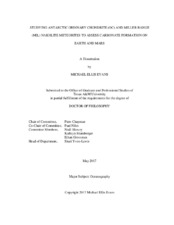| dc.contributor.advisor | Niles, Paul | |
| dc.contributor.advisor | Chapman, Piers | |
| dc.creator | Evans, Michael Ellis | |
| dc.date.accessioned | 2017-08-21T14:38:45Z | |
| dc.date.available | 2017-08-21T14:38:45Z | |
| dc.date.created | 2017-05 | |
| dc.date.issued | 2017-05-08 | |
| dc.date.submitted | May 2017 | |
| dc.identifier.uri | https://hdl.handle.net/1969.1/161465 | |
| dc.description.abstract | Carbonates are found in meteorites collected from Antarctica. The stable isotope composition of these carbonates records their formation environment on either Earth or Mars. The first research objective of this dissertation is to characterize the δ^18O and δ^13C values of terrestrial carbonates formed on Ordinary Chondrites (OCs) collected in regions near known martian meteorites. The second objective is to characterize the δ^18O and δ^13C values of martian carbonates from Nakhlites collected from the Miller Range (MIL). The third objective is to assess environmental changes on Mars since the Noachian period.
The OCs selected had no pre-terrestrial carbonates so any carbonates detected are presumed terrestrial in origin. The study methodology is stepped extraction of CO2 created from phosphoric acid reaction with meteorite carbonate.
Stable isotope results show that two distinct terrestrial carbonate species (Ca-rich and Fe/Mg-rich) formed in Antarctica on OCs from a thin-film of meltwater containing dissolved CO2. Carbon isotope data suggests the terrestrial carbonates formed in equilibrium with atmospheric CO2 δ^13C = -7.5‰ at >15°C. The wide variation in δ^18O suggests the carbonates did not form in equilibrium with meteoric water alone, but possibly formed from an exchange of oxygen isotopes in both water and dissolved CO2.
Antarctica provides a model for carbonate formation in a low water/rock ratio, near 0°C environment like modern Mars. Nakhlite parent basalt formed on Mars 1.3 billion years ago and the meteorites were ejected by a single impact approximately 11 million years ago. They traveled thru space before eventually falling to the Earth surface 10,000-40,000 years ago. Nakhlite samples for this research were all collected from the Miller Range (MIL) in Antarctica. The Nakhlite stable isotope results show two carbonate species (Ca-rich and Fe/Mg-rich) with a range of δ18O values that are similar to the terrestrial OC carbonates. The Nakhlite carbonates have distinctly different, heavier δ^13C values from a presumed martian carbon reservoir. These carbonates cannot form in equilibrium at 15°C with the modern Mars atmospheric CO2 (measured by the Curiosity rover) δ^13C = 46‰, but may reflect kinetic carbonate formation from a high pH fluid. Alternatively, the Nakhlite carbonates may have formed with a lighter, early Amazonian atmosphere of δ^13C ≈ 30‰. Assuming the martian carbonates formed in a thin-film environment like the OC terrestrial carbonates, an oxygen mixing model predicts early Amazonian martian meteoric water δ^18O = -30‰. | en |
| dc.format.mimetype | application/pdf | |
| dc.language.iso | en | |
| dc.subject | Mars | en |
| dc.subject | martian carbonate meteorite | en |
| dc.subject | d13C d18O stable isotope | en |
| dc.subject | "Ordinary Chondrite" | en |
| dc.subject | "Miller Range" Antarctica | en |
| dc.subject | Nakhlite | en |
| dc.title | Studying Antarctic Ordinary Chondrite (OC) and Miller Range (MIL) Nakhlite Meteorites to Assess Carbonate Formation on Earth and Mars | en |
| dc.type | Thesis | en |
| thesis.degree.department | Oceanography | en |
| thesis.degree.discipline | Oceanography | en |
| thesis.degree.grantor | Texas A & M University | en |
| thesis.degree.name | Doctor of Philosophy | en |
| thesis.degree.level | Doctoral | en |
| dc.contributor.committeeMember | Slowey, Niall | |
| dc.contributor.committeeMember | Shamberger, Kathryn | |
| dc.contributor.committeeMember | Grossman, Ethan | |
| dc.type.material | text | en |
| dc.date.updated | 2017-08-21T14:38:45Z | |
| local.etdauthor.orcid | 0000-0002-5137-1798 | |


